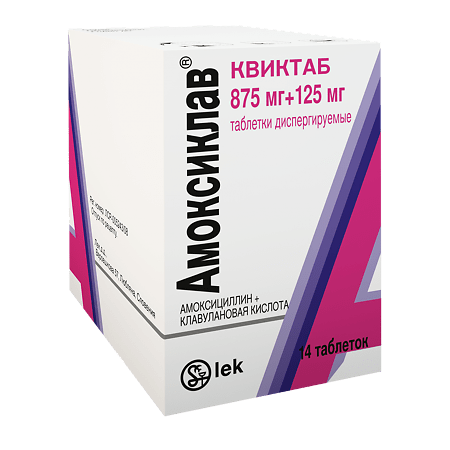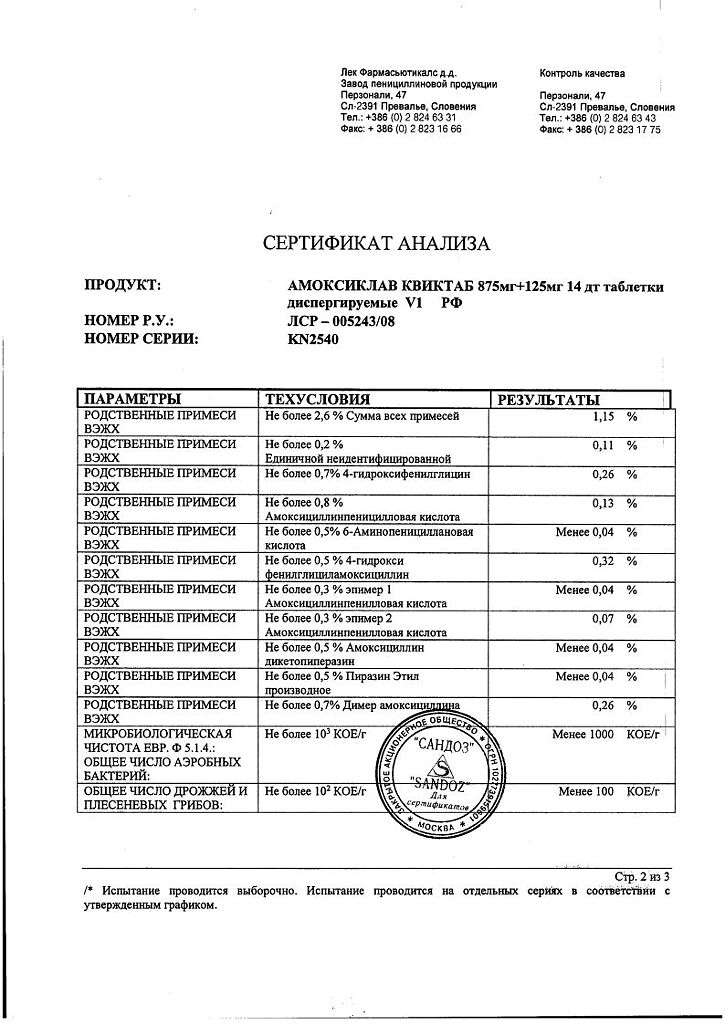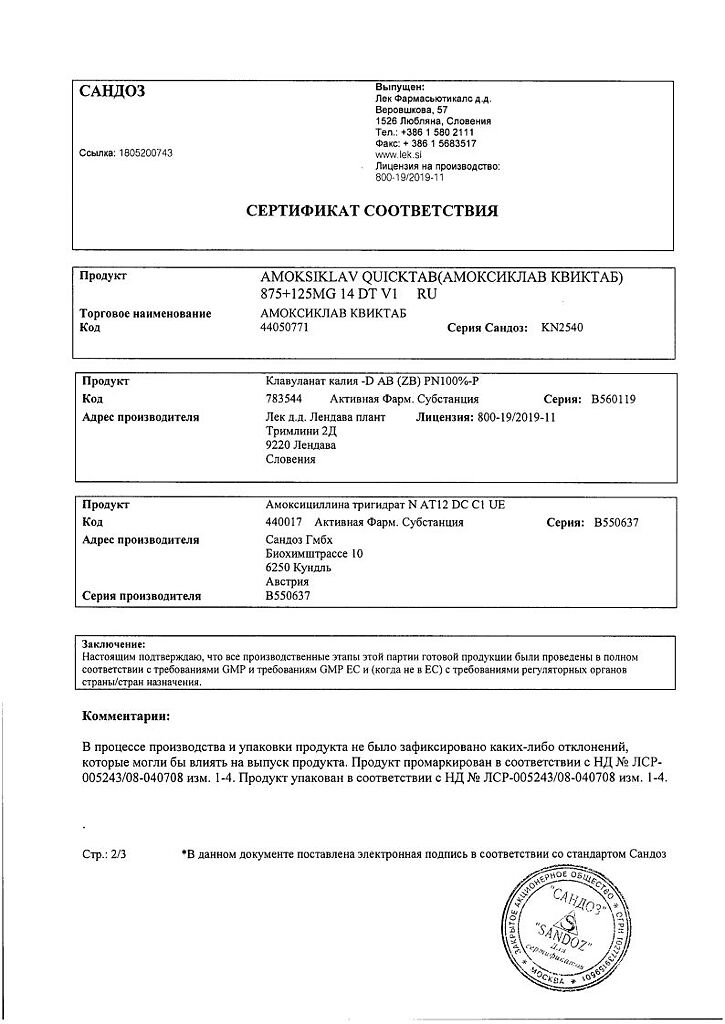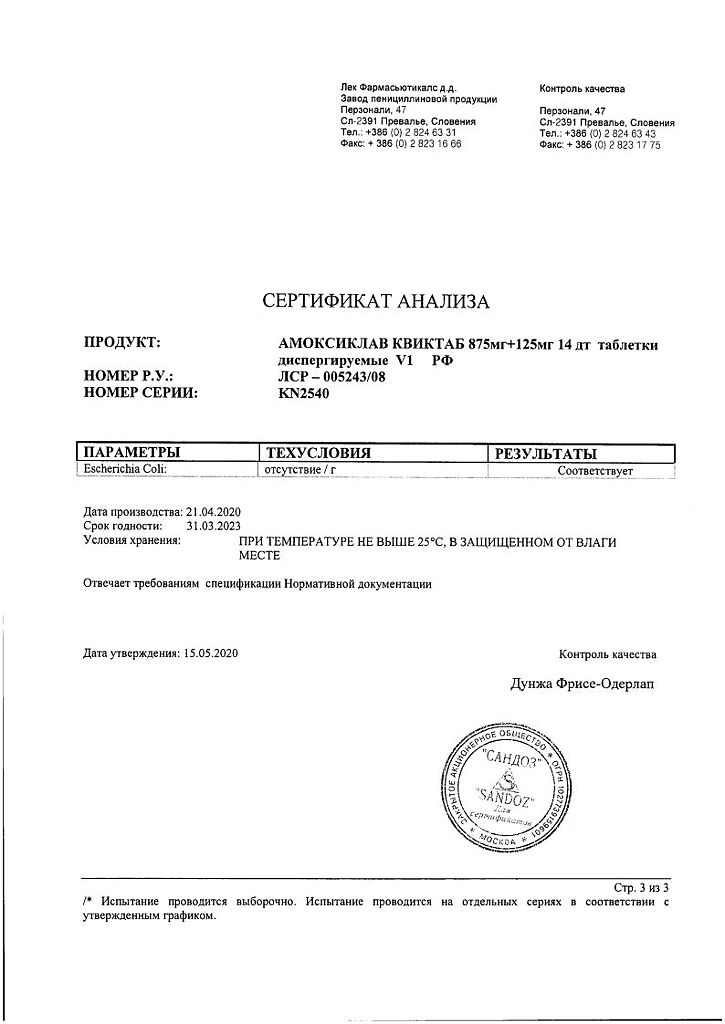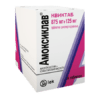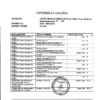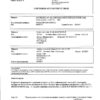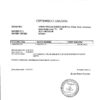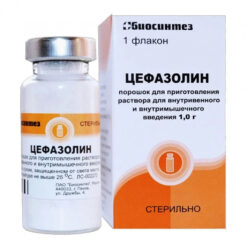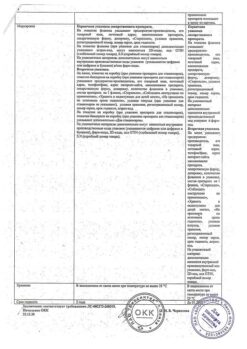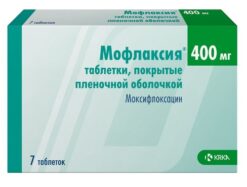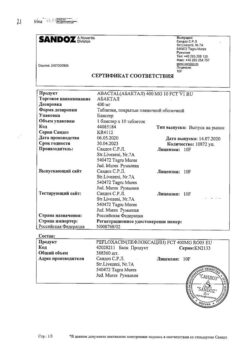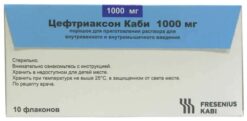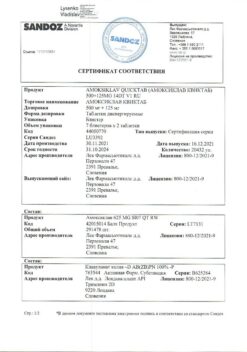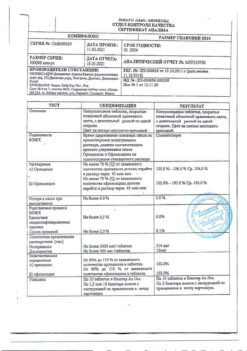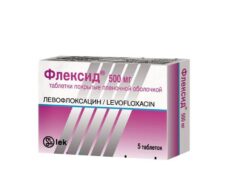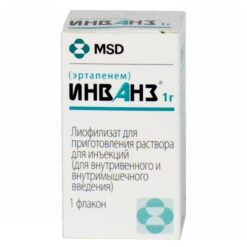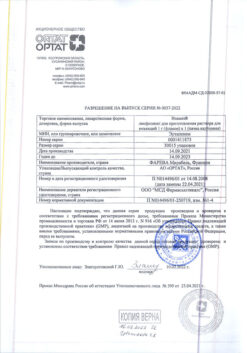No products in the cart.
Amoxiclav Quicktab, 875 mg+125 mg 14 pcs
€14.21 €11.84
Description
Pharmacological action – broad spectrum antibacterial, bactericidal.
Pharmacodynamics
The drug Amoxiclav® is a combination of amoxicillin and clavulanic acid.
Amoxicillin is a semisynthetic penicillin (beta-lactam antibiotic) that inhibits one or more enzymes (often referred to as penicillin-binding proteins, PRPs) in the peptidoglycan biosynthesis pathway, which is an integral structural component of the bacterial cell wall. Inhibition of peptidoglycan synthesis leads to loss of cell wall strength, which usually causes lysis and cell death of microorganisms.
Amoxicillin is degraded by the action of beta-lactamases produced by resistant bacteria, so that the spectrum of activity of amoxicillin does not include microorganisms that produce these enzymes.
Clavulanic acid is a beta-lactam that is structurally related to penicillins. It inhibits some beta-lactamases, thereby preventing inactivation of amoxicillin and broadening its spectrum of activity to include bacteria normally resistant to amoxicillin as well as other penicillins and cephalosporins. Clavulanic acid itself has no clinically significant antibacterial activity.
The drug Amoxiclav® has a bactericidal effect in vivo on the following microorganisms:
– Gram-positive aerobes – Staphylococcus aureus*, Streptococcus pneumoniae, Streptococcus pyogenes;
– Gram-negative aerobes – Enterobacter spp.**, Escherichia coli*, Haemophilus influenzae*, species of the genus Klebsiella*, Moraxella catarrhalis* (Branhamella catarrhalis).
The drug Amoxiclav® has a bactericidal effect in vitro against the following microorganisms (but clinical significance is still unknown):
– Gram-positive aerobes – Bacillis anthracis*, species of the genus Corynebacterium, Enterococcus faecalis*, Enterococcus faecium*, Listeria monocytogenes, Nocardia asteroides, coagulazonegative staphylococci* (including Staphylococcus epidermidis), Streptococcus agalactiae, other species of the genus Streptococcus, Streptococcus viridans;
– gram-positive anaerobes – species of the genus Clostridium, species of the genus Peptococcus, species of the genus Peptostreptococcus;
– gram-negative aerobes – Bordetella pertussis, species of the genus Brucella, Gardnerella vaginalis, Helicobacter pylori, species of the genus Legionella, Neisseria gonorrhoeae*, Neisseria meningitidis*, Pasteurella multocida, Proteus mirabilis*, Proteus vulgaris*, species of the genus Salmonella*, species of the genus Shigella*, Vibrio cholerae, Yersinia enterocolitica*;
– gram-negative anaerobes – species of the genus Bacteroides* (including Bacteroides fragilis), species of the genus Fusobacterium*;
– others – Borrelia burgdorferi, Chlamydia spp., Leptospira icterohaemorrhagiae, Treponema pallidum.
* Some strains of these bacterial species produce beta-lactamases, which contributes to their insensitivity to amoxicillin monotherapy.
** Most strains of these bacteria are resistant to the amoxicillin/clavulanic acid combination in vitro, but the clinical effectiveness of this combination has been demonstrated in the treatment of urinary tract infections caused by these strains.
Pharmacokinetics
The main pharmacokinetic parameters of amoxicillin and clavulanic acid are similar. Amoxicillin and clavulanic acid are well soluble in aqueous solutions with physiological pH value and after oral administration of Amoxiclav® are quickly and completely absorbed from the gastrointestinal tract. Absorption of the active substances – amoxicillin and clavulanic acid – is optimal when the drug is taken at the beginning of a meal.
The bioavailability of amoxicillin and clavulanic acid after oral administration is about 70%.
The peak of plasma concentrations is reached approximately 1 hour after ingestion. Values of Cmax for amoxicillin (depending on the dose) are 3-12 mcg/ml, for clavulanic acid – about 2 mcg/ml.
The Cmax in plasma after a bolus injection of 1.2 g (1000+200 mg) of the drug is 105.4 mg/L for amoxicillin and 28.5 mg/L for clavulanic acid.
When using Amoxiclav® plasma concentrations of amoxicillin/clavulanic acid are similar to those when administering orally the corresponding doses of amoxicillin or clavulanic acid separately in equivalent doses.
The two components are characterized by sufficient Vd in various organs, tissues and body fluids (including lungs, abdominal cavity organs; fat, bone and muscle tissues; pleural, synovial and peritoneal fluids; skin, bile, urine, purulent secretions, sputum, interstitial fluid).
The plasma protein binding is moderate – 25% for clavulanic acid and 18% for amoxicillin.
The Vd is approximately 0.3-0.4 L/kg for amoxicillin and approximately 0.2 L/kg for clavulanic acid.
Amoxicillin and clavulanic acid do not penetrate the blood-brain barrier in non-inflamed cerebral membranes.
Amoxicillin (like most penicillins) is excreted with breast milk. Trace amounts of clavulanic acid are also found in breast milk. Amoxicillin and clavulanic acid penetrate the placental barrier.
Amoxicillin is excreted mainly by the kidneys, whereas clavulanic acid is excreted through both renal and extrarenal mechanisms. After a single oral administration of one tablet of 250+125 mg or 500+125 mg, approximately 60-70% of amoxicillin and 40-65% of clavulanic acid are excreted unchanged in the urine during the first 6 h. About 10-25% of the initial dose of amoxicillin is excreted with urine as inactive penicillic acid. Clavulanic acid in humans undergoes intensive metabolism to form 2,5-dihydro-4-(2-hydroxyethyl)-5-oxo-1H-pyrrol-3-carboxylic acid and 1-amino-4-hydroxy-butane-2-one and is excreted with urine and feces.
The average T1/2 of amoxicillin/clavulanic acid is approximately 1 h, the average total clearance is approximately 25 L/h in healthy patients. Various studies have found that urinary excretion of amoxicillin within 24 h is approximately 50-85%, clavulanic acid 27-60%. The greatest amount of clavulanic acid is excreted during the first 2 hours after intake.
The pharmacokinetic parameters of amoxicillin and clavulanic acid are summarized in Table 1.
Table 1
500 mg/125 mg<td/tr>
| Mean (±SD) pharmacokinetic values | ||||||
| Active ingredients Amoxicillin/clavulanic acid | Dose, mg | Cmax, μg/mL | Tmax, h | AUC(0-24), μg-h/mL <td/td> | T1/2, h | |
| Amoxicillin | ||||||
| 875 mg/125 mg | 875 | 11.64±2.78 | 1.5 (1-2.5) | 53.52±12.31 | 1.19±0.21 | |
| 500 | 7.19±2.26 | 1.5 (1-2.5) | 53.52±8.37 | 1.15±0.2 | ||
| Clavulanic acid | ||||||
| 875 mg/125 mg | 125 | 2.18±0.99 | 1.25 (1-2) | 10.16±3.04 | 0.96±0.12 | |
| 500 mg/125 mg | 125 | 2.4±0.83 | 1.5 (1-2) | 15.52±3.86 | 0.98±0.12 | |
Patients with impaired liver function
In patients with severe renal impairment, the T1/2 is increased up to 7.5 h for amoxicillin and up to 4.5 h for clavulanic acid.
In patients with hepatic impairment the dose of the drug should be adjusted with caution: continuous monitoring of the liver condition is necessary.
The two components are eliminated by hemodialysis and minor amounts by peritoneal dialysis.
Indications
Indications
For all dosage forms
Infections caused by sensitive strains of microorganisms:
upper respiratory tract and ENT organs (including acute and chronic sinusitis, acute and chronic otitis media, retropharyngeal abscess, tonsillitis, pharyngitis);
lower respiratory tract (including acute bronchitis with bacterial superinfection, chronic bronchitis, pneumonia);
urinary tract (eg cystitis, urethritis, pyelonephritis);
in gynecology;
skin and soft tissues, including human and animal bites;
bone and connective tissue;
biliary tract (cholecystitis, cholangitis);
odontogenic.
Pharmacological effect
Pharmacological effect
Pharmacological action – broad spectrum antibacterial, bactericidal.
Pharmacodynamics
The drug Amoxiclav® is a combination of amoxicillin and clavulanic acid.
Amoxicillin is a semisynthetic penicillin (beta-lactam antibiotic) that inhibits one or more enzymes (often referred to as penicillin-binding proteins, PBPs) in the biosynthesis pathway of peptidoglycan, an integral structural component of the bacterial cell wall. Inhibition of peptidoglycan synthesis leads to a loss of cell wall strength, which usually causes lysis and death of microbial cells.
Amoxicillin is destroyed by the action of beta-lactamases produced by resistant bacteria, so the spectrum of activity of amoxicillin does not include microorganisms that produce these enzymes.
Clavulanic acid is a beta-lactam structurally related to penicillins. It inhibits some beta-lactamases, thereby preventing the inactivation of amoxicillin and expanding its spectrum of activity, including bacteria usually resistant to amoxicillin, as well as to other penicillins and cephalosporins. Clavulanic acid itself does not have a clinically significant antibacterial effect.
The drug Amoxiclav® has a bactericidal effect in vivo on the following microorganisms:
– gram-positive aerobes – Staphylococcus aureus*, Streptococcus pneumoniae, Streptococcus pyogenes;
– gram-negative aerobes – Enterobacter spp.**, Escherichia coli*, Haemophilus influenzae*, species of the genus Klebsiella*, Moraxella catarrhalis* (Branhamella catarrhalis).
The drug Amoxiclav® has a bactericidal effect in vitro on the following microorganisms (however, the clinical significance is still unknown):
– gram-positive aerobes – Bacillis anthracis*, species of the genus Corynebacterium, Enterococcus faecalis*, Enterococcus faecium*, Listeria monocytogenes, Nocardia asteroides, coagulase-negative staphylococci* (including Staphylococcus epidermidis), Streptococcus agalactiae, other species of the genus Streptococcus, Streptococcus viridans;
– gram-positive anaerobes – species of the genus Clostridium, species of the genus Peptococcus, species of the genus Peptostreptococcus;
– gram-negative aerobes – Bordetella pertussis, species of the genus Brucella, Gardnerella vaginalis, Helicobacter pylori, species of the genus Legionella, Neisseria gonorrhoeae*, Neisseria meningitidis*, Pasteurella multocida, Proteus mirabilis*, Proteus vulgaris*, species of the genus Salmonella*, species of the genus Shigella*, Vibrio cholerae, Yersinia enterocolitica*;
– gram-negative anaerobes – species of the genus Bacteroides* (including Bacteroides fragilis), species of the genus Fusobacterium*;
– others – Borrelia burgdorferi, Chlamydia spp., Leptospira icterohaemorrhagiae, Treponema pallidum.
* Some strains of these bacterial species produce beta-lactamases, which contributes to their insensitivity to amoxicillin monotherapy.
** Most strains of these bacteria are resistant to the amoxicillin/clavulanic acid combination in vitro, but the clinical effectiveness of this combination has been demonstrated in the treatment of urinary tract infections caused by these strains.
Pharmacokinetics
The main pharmacokinetic parameters of amoxicillin and clavulanic acid are similar. Amoxicillin and clavulanic acid are highly soluble in aqueous solutions with a physiological pH value and, after taking Amoxiclav® orally, they are quickly and completely absorbed from the gastrointestinal tract. Absorption of the active substances – amoxicillin and clavulanic acid – is optimal when taking the drug at the beginning of a meal.
The bioavailability of amoxicillin and clavulanic acid after oral administration is about 70%.
Peak plasma concentrations are reached approximately 1 hour after administration. Cmax values are 3–12 μg/ml for amoxicillin (depending on the dose), and about 2 μg/ml for clavulanic acid.
Cmax in blood plasma after a bolus injection of 1.2 g (1000+200 mg) of the drug is 105.4 mg/l for amoxicillin and 28.5 mg/l for clavulanic acid.
When using the drug Amoxiclav®, plasma concentrations of amoxicillin/clavulanic acid are similar to those when taking corresponding doses of amoxicillin or clavulanic acid orally in equivalent doses.
Both components are characterized by sufficient Vd in various organs, tissues and fluids of the body (including the lungs, abdominal organs; adipose, bone and muscle tissues; pleural, synovial and peritoneal fluids; skin, bile, urine, purulent discharge, sputum, interstitial fluid).
Plasma protein binding is moderate – 25% for clavulanic acid and 18% for amoxicillin.
Vd is approximately 0.3–0.4 L/kg for amoxicillin and approximately 0.2 L/kg for clavulanic acid.
Amoxicillin and clavulanic acid do not penetrate the blood-brain barrier when the meninges are not inflamed.
Amoxicillin (like most penicillins) is excreted in breast milk. Trace amounts of clavulanic acid are also found in breast milk. Amoxicillin and clavulanic acid penetrate the placental barrier.
Amoxicillin is eliminated primarily by the kidneys, while clavulanic acid is eliminated through both renal and extrarenal mechanisms. After a single oral dose of one tablet 250+125 mg or 500+125 mg, approximately 60–70% of amoxicillin and 40–65% of clavulanic acid are excreted unchanged in the urine during the first 6 hours. About 10–25% of the initial dose of amoxicillin is excreted in the urine as inactive penicillic acid. Clavulanic acid in the human body undergoes intensive metabolism with the formation of 2,5-dihydro-4-(2-hydroxyethyl)-5-oxo-1H-pyrrole-3-carboxylic acid and 1-amino-4-hydroxy-butan-2-one and is excreted in urine and feces.
The average T1/2 of amoxicillin/clavulanic acid is approximately 1 hour, the average total clearance is approximately 25 l/h in healthy patients. Various studies have found that urinary excretion of amoxicillin within 24 hours is approximately 50–85%, and that of clavulanic acid is 27–60%. The largest amount of clavulanic acid is excreted during the first 2 hours after administration.
The pharmacokinetic parameters of amoxicillin and clavulanic acid are summarized in Table 1.
Table 1
Mean (±SD) pharmacokinetic parameters
Active ingredients: Amoxicillin/clavulanic acid
Dose, mg
Cmax, µg/ml
Tmax, h
AUC(0–24), µg h/ml
T1/2, h
Amoxicillin
875 mg/125 mg
875
11.64±2.78
1.5 (1–2.5)
53.52±12.31
1.19±0.21
500 mg/125 mg
500
7.19±2.26
1.5 (1–2.5)
53.52±8.37
1.15±0.2
Clavulanic acid
875 mg/125 mg
125
2.18±0.99
1.25 (1–2)
10.16±3.04
0.96±0.12
500 mg/125 mg
125
2.4±0.83
1.5 (1–2)
15.52±3.86
0.98±0.12
Patients with liver dysfunction
In patients with severe renal failure, T1/2 increases to 7.5 hours for amoxicillin and to 4.5 hours for clavulanic acid.
For patients with impaired liver function, the dose of the drug should be selected with caution: constant monitoring of the condition of the liver is necessary.
Both components are removed by hemodialysis and minor amounts by peritoneal dialysis.
Special instructions
Special instructions
For all dosage forms
During a course of treatment, it is necessary to monitor the state of the function of the hematopoietic organs, liver, and kidneys.
In patients with severe renal impairment, adequate dose adjustment or increased intervals between doses is required.
It is possible that superinfection may develop due to the growth of microflora that is insensitive to it, which requires a corresponding change in antibacterial therapy.
In patients who are hypersensitive to penicillins, cross-allergic reactions with cephalosporin antibiotics are possible.
In women with premature rupture of membranes, it was found that prophylactic therapy with amoxicillin + clavulanic acid may be associated with an increased risk of developing necrotizing colitis in the newborn.
Crystalluria very rarely occurs in patients with reduced diuresis. During the use of large doses of amoxicillin, it is recommended to take sufficient fluids and maintain adequate diuresis to reduce the likelihood of amoxicillin crystal formation.
Laboratory tests. High concentrations of amoxicillin give a false-positive reaction to urine glucose when using Benedict’s reagent or Fehling’s solution. It is recommended to use enzymatic reactions with glucosidase.
For dispersible tablets and powder for the preparation of suspension for oral administration additionally
Before starting treatment, it is necessary to interview the patient to identify a history of hypersensitivity reactions to penicillins, cephalosporins or other beta-lactam antibiotics.
In order to reduce the risk of side effects from the gastrointestinal tract, you should take the drug before or during meals.
When using high doses of Amoxiclav®Quictab in patients with crystalluria, it is necessary to adequately replace fluid loss.
If antibiotic-associated colitis occurs, Amoxiclav® Quiktab should be immediately discontinued, consult a doctor and begin appropriate treatment. Drugs that inhibit peristalsis are contraindicated in such situations.
Treatment must continue for another 48–72 hours after the disappearance of clinical signs of the disease. When using estrogen-containing oral contraceptives and amoxicillin simultaneously, other or additional methods of contraception should be used.
Amoxicillin and clavulanic acid can provoke nonspecific binding of immunoglobulins and albumins to the erythrocyte membrane, which can cause a false positive reaction with the Coombs test.
The use of amoxicillin and clavulanic acid is contraindicated in infectious mononucleosis, because may cause a measles-like rash.
Special precautions when disposing of unused medicinal products. There is no need for special precautions when disposing of unused Amoxiclav®.
Impact on the ability to drive a car or perform work that requires increased speed of physical and mental reactions. Due to the possibility of developing side effects from the central nervous system, such as dizziness, headache, convulsions, during treatment, care should be taken when driving and other activities that require concentration and speed of psychomotor reactions.
Amoxiclav®
Amoxiclav® Quiktab
For film-coated tablets, dispersible tablets, powder for the preparation of suspension for oral administration additionally
In order to reduce the risk of side effects from the gastrointestinal tract, you should take the drug with meals.
Active ingredient
Active ingredient
Amoxicillin, Clavulanic acid
Composition
Composition
Film-coated tablets:
active substances (core):
amoxicillin (in trihydrate form) – 875 mg,
clavulanic acid (in the form of potassium salt) – 125 mg,
excipients: colloidal silicon dioxide – 12 mg; crospovidone – 61 mg; croscarmellose sodium – 47 mg; magnesium stearate – 17.22 mg; MCC – up to 1435 mg,
film shell: hypromellose – 23.226 mg; ethylcellulose – 1.134 mg; polysorbate 80 – 1.26 mg; triethyl citrate – 1.28 mg; titanium dioxide – 12.286 mg; talc – 2.814 mg.
Pregnancy
Pregnancy
During pregnancy and lactation, Amoxiclav® is used only if the expected benefit to the mother outweighs the potential risk to the fetus and child.
Amoxiclav® Quiktab can be prescribed during pregnancy if there are clear indications.
Amoxicillin and clavulanic acid pass into breast milk in small quantities.
Contraindications
Contraindications
hypersensitivity to the components of the drug;
history of hypersensitivity to penicillins, cephalosporins and other beta-lactam antibiotics;
history of cholestatic jaundice and/or other liver dysfunction caused by taking amoxicillin/clavulanic acid;
infectious mononucleosis and lymphocytic leukemia;
For Amoxiclav® Quiktab dispersible tablets additionally
children under 12 years of age or weighing less than 40 kg.
phenylketonuria;
renal failure (creatinine Cl <30 ml/min) (for dispersible tablets 875 mg + 125 mg)
With caution: history of pseudomembranous colitis, gastrointestinal diseases, liver failure, severe renal impairment, pregnancy, lactation, simultaneous use with anticoagulants.
Side Effects
Side Effects
Amoxiclav® film-coated tablets and powder for the preparation of a solution for intravenous administration
From the digestive system: loss of appetite, nausea, vomiting, diarrhea, abdominal pain, gastritis, stomatitis, glossitis, black “hairy” tongue, darkening of tooth enamel, hemorrhagic colitis (can also develop after therapy), enterocolitis, pseudomembranous colitis, impaired liver function, increased activity of ALT, AST, alkaline phosphatase and/or bilirubin levels in the blood plasma, hepatic failure (more often in the elderly, men, with long-term therapy), cholestatic jaundice, hepatitis.
Allergic reactions: itching, urticaria, erythematous rashes, erythema multiforme exudative, angioedema, anaphylactic shock, allergic vasculitis, exfoliative dermatitis, Stevens-Johnson syndrome, acute generalized exanthematous pustulosis, a syndrome similar to serum sickness, toxic epidermal necrolysis.
From the hematopoietic system and lymphatic system: reversible leukopenia (including neutropenia), thrombocytopenia, hemolytic anemia, reversible increase in PT (when used together with anticoagulants), reversible increase in bleeding time, eosinophilia, pancytopenia, thrombocytosis, agranulocytosis.
From the central nervous system: dizziness, headache, convulsions (may occur in patients with impaired renal function when taking high doses of the drug).
From the urinary system: interstitial nephritis, crystalluria, hematuria.
Other: candidiasis and other types of superinfection.
Amoxiclav®
For film-coated tablets, powder for the preparation of a suspension for oral administration, powder for the preparation of a solution for intravenous administration additionally
From the side of the central nervous system: hyperactivity. Feelings of anxiety, insomnia, behavior changes, agitation.
Interaction
Interaction
For all dosage forms
Antacids, glucosamine, laxatives, aminoglycosides slow down absorption, ascorbic acid increases absorption.
Diuretics, allopurinol, phenylbutazone, NSAIDs and other drugs that block tubular secretion (probenecid) increase the concentration of amoxicillin (clavulanic acid is excreted mainly by glomerular filtration).
The simultaneous use of Amoxiclav® and methotrexate increases the toxicity of methotrexate.
Prescription together with allopurinol increases the incidence of exanthema. Concomitant use with disulfiram should be avoided.
Reduces the effectiveness of drugs, during the metabolism of which PABA is formed; ethinyl estradiol – risk of breakthrough bleeding.
The literature describes rare cases of increased INR in patients with the combined use of acenocoumarol or warfarin and amoxicillin. If simultaneous use with anticoagulants is necessary, PT or INR should be carefully monitored when prescribing or discontinuing the drug.
The combination with rifampicin is antagonistic (mutual weakening of the antibacterial effect). The drug Amoxiclav® should not be used simultaneously in combination with bacteriostatic antibiotics (macrolides, tetracyclines), sulfonamides due to a possible decrease in the effectiveness of the drug Amoxiclav®.
The drug Amoxiclav® reduces the effectiveness of oral contraceptives.
For dispersible tablets and powder for the preparation of suspension for oral administration additionally
Increases the effectiveness of indirect anticoagulants (suppressing intestinal microflora, reduces the synthesis of vitamin K and the prothrombin index). In some cases, taking the drug may prolong PT; therefore, caution should be exercised when using anticoagulants and the drug Amoxiclav®Quictab simultaneously.
Probenecid reduces the excretion of amoxicillin, increasing its serum concentration.
In patients receiving mycophenolate mofetil, after starting the combination of amoxicillin with clavulanic acid, a decrease in the concentration of the active metabolite, mycophenolic acid, was observed before taking the next dose of the drug by approximately 50%. Changes in this concentration may not accurately reflect overall changes in mycophenolic acid exposure.
Overdose
Overdose
There are no reports of death or life-threatening side effects due to drug overdose.
Symptoms: in most cases – gastrointestinal disorders (abdominal pain, diarrhea, vomiting), anxiety, insomnia, dizziness are also possible, and in isolated cases – seizures.
Treatment: in case of overdose, the patient should be under medical supervision, treatment should be symptomatic.
In case of recent use (less than 4 hours) of the drug, it is necessary to perform gastric lavage and prescribe activated charcoal to reduce absorption. Amoxicillin/potassium clavulanate is removed by hemodialysis.
Storage conditions
Storage conditions
In a place protected from moisture, at a temperature not exceeding 25 °C
Shelf life
Shelf life
3 years
Manufacturer
Manufacturer
Lek d.d., Slovenia
Additional information
| Shelf life | 3 years |
|---|---|
| Conditions of storage | In a moisture-proof place, at a temperature not exceeding 25 °C |
| Manufacturer | Lek d.d., Slovenia |
| Medication form | dispersible tablets |
| Brand | Lek d.d. |
Related products
Buy Amoxiclav Quicktab, 875 mg+125 mg 14 pcs with delivery to USA, UK, Europe and over 120 other countries.

